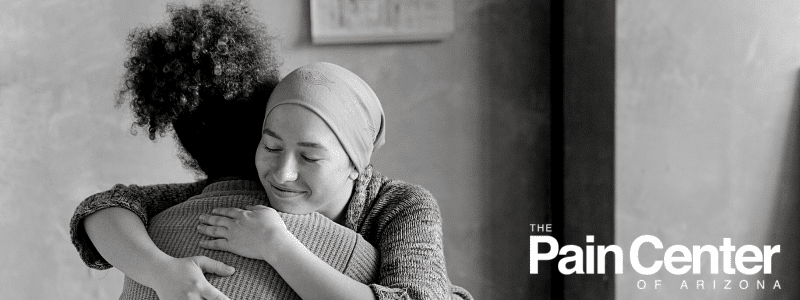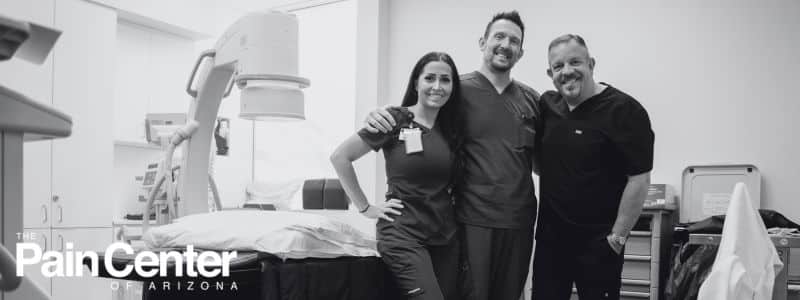
Ongoing pain is debilitating. It affects every aspect of life; spending time with people, exercising, doing house chores, sleeping, etc. It essentially leads to a poor quality of living, often being at the forefront of the mind.
In this blog, we’ll look at the following questions about chronic pain:
- What is chronic pain syndrome?
- What are the symptoms of chronic pain?
- What causes chronic pain syndrome?
- Is chronic pain permanent?
- Why is chronic pain hard to treat?
- What are some pitfalls in diagnosing chronic pain disorders?
- Are chronic pain syndromes psychosomatic?
- Why would someone with chronic pain refuse to seek help?
- What is the most painful chronic physical illness?
- Treatments for back pain offered at The Pain Center
What is Chronic Pain Syndrome?

Chronic Pain Syndrome is when a person experiences persistent pain from an injury or illness for 12 weeks or more, longer than the expected healing time.
What are the Symptoms of Chronic Pain?
While chronic pain is characterized by ongoing pain, this pain can feel and be experienced differently from one person to another.
Along with the actual pain itself, chronic pain syndrome is often accompanied by the following symptoms:
- Anxiety and depression
- Neuropathic pain (shooting, stabbing, or burning sensation due to problems with the central nervous system)
- Acute pain (sudden, sharp, or intense pain)
- Sleeping problems
- Pins and needles
- Headaches
- Loss of appetite
- Stiffness and soreness
- Mood swings and irritability
- Fatigue
- Reduced mobility
People with chronic pain syndrome may only have a few or many symptoms that manifest from the condition. What’s important is seeking help from a professional to prevent prolonged pain.
What Causes Chronic Pain Syndrome?

Chronic pain syndrome can develop due to several things, including:
- Existing injury. Injuries can cause tissue damage, leading to chronic pain and prolonged healing.
- Coexisting medical condition (including psychological such as depression or anxiety). Medical conditions like fibromyalgia, spinal stenosis, or arthritis significantly affect chronic pain. Mental health problems like depression, anxiety, and long-term stress can cause physical side effects like muscle spasms, contributing to chronic pain.
- Post-surgery. Pain often lingers following surgery. Without proper physical therapy or treatment, chronic pain can develop.
- Lifestyle. Habits of poor posture, sedentary living, and eating unhealthy foods contribute to physical problems like spine pain. Without addressing these issues, the pain can linger and progress.
- Environmental factors. Poor air quality or exposure to chemicals and toxins can harm the body and bring about chronic pain problems.
- Genetics. If certain conditions are inherited, such as fibromyalgia or sickle cell anemia, this can contribute to chronic pain, more so if the condition itself is not addressed.
Is Chronic Pain Permanent?
The Cleveland Clinic reports that chronic pain typically doesn’t go away but can be managed, reducing the pain score by 30%. Treatment usually includes physical therapy, pain medication, lifestyle changes, and sometimes surgeries.
Why is Chronic Pain Hard to Treat?
Chronic pain is complex, involving a combination of factors. Likewise, the best treatment path varies depending on a person’s individual needs and the reason behind their pain. Unlike other pain conditions, we’re still limited in our knowledge of chronic pain, making it more challenging to get to the root cause.
What are Some Pitfalls in Diagnosing Chronic Pain Disorders?

It’s common to confuse chronic pain with any type of pain that lasts longer than expected. It’s a painful condition that involves a variety of factors, both physical and psychological. Chronic pain is also usually affected by external things like the environment and social aspects.
Treatment for chronic pain sometimes only targets the physical aspects of the condition and neglects the psychological factors. Because of this, chronic pain may persist and be more difficult to reduce due to not looking at all the possible contributors.
Are Chronic Pain Syndromes Psychosomatic?
Psychosomatic factors can also contribute to chronic pain when combined with physical elements. Problems with mental health are strong enough to influence the body, causing physical manifestations like muscle aches and headaches. Other times, the impact of prolonged physical pain can lead to negative emotions like anxiety and stress.
Why Would Someone with Chronic Pain Refuse to Seek Help?
There are several reasons why a person may avoid seeking help for their chronic pain, including the following:
- Believing the pain will go away on its own
- Waiting for the pain to get to a certain degree first
- Fear of finding out there’s no cure or the presence of another condition
- Stigma that causes embarrassment and shame
- Not trusting healthcare providers to offer the best treatment option
- Not having the financial capabilities
- Not believing in traditional medicine
What is the Most Painful Chronic Physical Illness?
People experience chronic pain on varying levels. Pain is relative, and a condition that causes severe pain in one person may be moderate in another. Medically speaking, the illnesses that are typically associated with high levels of pain include:
- Fibromyalgia
- Endometriosis
- Multiple sclerosis (MS)
- Complex regional pain syndrome (CRPS)
- Rheumatoid arthritis
- Chronic migraines
- Cancer
Treatments for Back Pain Offered at The Pain Center

The Pain Center offers unique treatments for chronic pain that are FDA-approved and minimally invasive procedures that reduce pain with minimal downtime and discomfort.
Our treatments include:
TPC Spine Stim
TPC Spine Stim is for patients with chronic back or leg pain who haven’t responded to alternative, conservative treatments in the past six months. The TPC Spine Stim works by implanting a nerve stimulation device into your spine. This device delivers low-voltage electrical currents to areas of the spine to reduce the pain signals causing chronic pain.
TPC Spine Fuse
TPC Spine Fuse targets spinal degeneration, usually brought on by stenosis, spondylolisthesis, and related conditions. It works to alleviate pain due to pressure on the spinal cord and instability that causes painful movements of the vertebrate.
In this procedure, a small incision goes into the back under live X-ray guidance. A device is placed between the spinous processes that fuse the segment. This gives the back stability, where the bones shift forward and backward. Our procedure can also be done through alternative approaches (a posterior, oblique, or lateral approach) depending on each individual’s needs.
TPC Spine Lift
TPC Spine Lift is a spinal decompression treatment aiming to relieve spinal nerve pressure pain. This procedure is designed to aid patients suffering from chronic pain due to spinal stenosis and related conditions.
Our procedure uses the Vertiflex technique, lifting the space where the lumbar vertebrae are narrowing or bulging (often resulting from spinal stenosis). This process is done under a live X-ray as guidance, placing a small device that opens up the pressure area.
TPC Sacral Fuse
TPC Sacral Fuse provides stability to the joints of patients with sacroiliac joint dysfunction. This condition can cause pain with too little or too much joint movement.
Under live X-ray guidance, a small device is placed into the sacroiliac joint, fusing the joint. Fusing the joint creates better stability, targeting pain caused by movement and instability.
TPC Peripheral Nerve Stimulation
TPC Peripheral Nerve Stimulation offers pain relief to patients suffering from peripheral neuropathy and related conditions. A small electrical wire is surgically implanted along the damaged nerves and delivers rapid electrical pulses. These pulses feel like mild tingles, called paresthesias, and help to minimize pain.
TPC Spine Decompress
TPC Spine Decompress offers a minimally invasive method of pain relief for patients with spinal stenosis. In this treatment procedure, a small trocar needle is used to locate where the narrowing is causing the pain is occurring. Following this, we use a small instrument called the rongeur to remove excessive bone or tissue to open the area.



